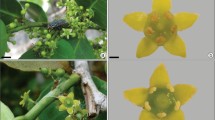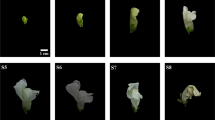Abstract
Programmed cell death (PCD), a topic of abiding interest, remodels plants at the cell, tissue, and organ levels involving various developmental processes of plants. The aim of this study is to provide a morphological characterization of evidence of PCD involvement in the laticiferous canal formation in fruit of Decaisnea fargesii. Several ultrastructural features of PCD have been observed including disintegration of vacuole and plasma membranes, cell wall degeneration, degenerated cytoplasm, abundant membrane structures and flocculent material, mitochondria and misshapen nuclei coupled with degraded plastids in vacuoles, and nuclei enveloped by rubber granule. In D. fargesii, the nuclei of the secretory epidermal cells become TUNEL-positive from the sunken stage to the late expanding stage, then DAPI-negative during the mature stage, indicating an early event of deoxyribonucleic acid (DNA) cleavage and a late event of complete DNA degeneration. Gel electrophoresis indicates that DNA cleavage is random and does not result in the laddering pattern indicating multiples of internucleosomal units. During the PCD of secretory epidermal cells, the rubber granules continue to be synthesized and accumulated in the secretory epidermal cells despite nuclear degradation. The PCD’s role in laticiferous canal formation suggests that PCD may play important roles in gland development of plants.









Similar content being viewed by others
Abbreviations
- PCD:
-
programmed cell death
- TUNEL:
-
terminal deoxynucleotidyl transferase-mediated dUTP nick end labeling
References
Belmonte E, Cardemil L, Kalin Arroyo MT (1994) Floral nectary structure and nectar composition in Eccremocarpus scaber (Bignoniaceae), a hummingbird pollinated plant of central Chile. Am J Bot 81:493–503
Carr DJ, Carr SGM (1970) Oil glands and ducts in Eucalyptus L`Herit. II. Development and structure of oil glands in the embryo. Austral J Bot 18:191–212
Courtois-Moreau CL, Pesquet E, Sjödin A, Muniz L, Bollhöner B, Kaneda M, Samuels L, Jansson S, Tuominen H (2009) A unique program for cell death in xylem fibers of Populus stem. Plant J 58:260–274
Dangl JL, Dietrich RA, Thomas H (2000) Senescence and programmed cell death. In: Buchanan B, Gruissem W, Jones R (eds) Biochemistry and molecular biology of plants. American Society of Plant Biologists, Rockville, pp 1044–1100
Evert RF (2006) Esau’s plant anatomy, 3rd edn. Wiley, Hoboken, pp 455–462
Fukuda H (2000) Programmed cell death of tracheary elements as a paradigm in plants. Plant Mol Biol 44:245–253
Gaffal KP, Friedrichs GJ, El-Gammal S (2007) Ultrastructural evidence for a dual function of the phloem and programmed cell death in the floral nectary of Digitalis purpurea. Ann Bot 99:593–607
Galetto L (1995) Nectary structure and nectar characteristics in some Bignoniaceae. Pl Syst Evol 196:99–121
Gibbons IR, Grimstone AV (1960) On the flagellate structure in certain flagellates. J Biophys Biochem Cytol 7:697–716
Groover A, Jones AM (1999) Tracheary element differentiation uses a novel mechanism coordinating programmed cell death and secondary cell wall synthesis. Plant Physiol 119:375–384
Gunawardena AH, Pearce DM, Jackson MB, Hawes CR, Evans DE (2001) Characterisation of programmed cell death during aerenchyma formation induced by ethylene or hypoxia in roots of maize (Zea mays L.). Planta 212:205–214
Gunawardena A, Greenwood JS, Dengler N (2004) Programmed cell death remodels lace plant leaf shape during development. Plant Cell 16:70–73
Gunawardena AH, Sault K, Donnelly P, Greenwood JS, Dengler NG (2005) Programmed cell death and leaf morphogenesis in Monstera obliqua (Araceae). Planta 221:607–618
Hagel JM, Yeung EC, Facchini PJ (2008) Got milk? The secret life of laticifers. Trends Plant Sci 13:631–639
Horner HT, Healy RA, Cervantes-Martinez T, Palmer RG (2003) Floral nectary fine structure and development in Glycine max L. (Fabaceae). Int J Plant Sci 164:675–690
Hu ZH (1963) Studies on the structure and the ontogeny of laticiferous canals of Decaisnea fargesii Franch. Acta Bot Sin 11:129–140
Huang BQ, Strout WG, Russell SD (1993) Fertilization in Nicotiana tabacum—ultrastructural organization of propane—jet-frozen embryo sacs in-vivo. Planta 191:256–264
Jones AM (2001) Programmed cell death in development and defense. Plant Physiol 125:94–97
Kozela C, Regan S (2003) How plants make tubes. Trends Plant Sci 8:159–164
Krishnamurthy KV, Krishnaraj R, Chozhavendan R, Christopher FS (2000) The programme of cell death in plants and animals—a comparison. Curr Sci 79:1169–1181
Kronestedt EC, Robards AW, Strak M, Olesen P (1986) Development of trichomes in the Abutilon nectary gland. Nord J Bot 6:627–639
Liu WZ, Zhou YF, Wang X, Jiao ZJ (2010) Programmed cell death during pigment gland formation in Gossypium hirsutum leaves. Plant Biol 12:895–902
Mastroberti AA, de Araujo Mariath JE (2008) Development of mucilage cells of Araucaria angustifolia (Araucariaceae). Protoplasma 232:233–245
Monacelli B, Valletta A, Rascio N, Moro I, Pasqua G (2005) Laticifers in Camptotheca acuminata Decne: distribution and structure. Protoplasma 226:155–161
O’Brien SP, Loveys BR, Grant WJR (1996) Ultrastructure and function of floral nectaries of Chamelaucium uncinatum (Myrtaceae). Ann Bot 78:189–196
Pennell RI, Lamb C (1997) Programmed cell death in plants. Plant Cell 9:1157–1168
Reynolds ES (1963) The use of lead citrate at high pH as an electron-opaque stain in electron microscopy. J Cell Biol 17:208–212
Roberts K, McCann MC (2000) Xylogenesis: the birth of a corpse. Curr Opin Plant Biol 3:517–522
Robinson DG, Galili G, Herman E, Hillmer S (1998) Topical aspects of vacuolar protein transport: autophagy and prevacuolar compartments. J Exp Bot 49:1263–1270
Sineonova E, Sikora A, Charzynska M, Mostowska A (2000) Aspects of programmed cell death during leaf senescence of mono- and dicotyle donous plants. Protoplasma 214:93–101
Smart CM (1994) Tansley review no. 64: gene expression during leaf senescence. New Phytol 126:419–448
Turner GW (1999) A brief history of the lysigenous gland hypothesis. Bot Rev 65:76–88
Turner S, Gallois P, Brown D (2007) Tracheary element differentiation. Annu Rev Plant Biol 58:407–433
Wang YQ, Cui KM (1998) Programmed cell death during secondary xylem in Eucommia ulmoides shoots. Acta Bot Sin 40:1102–1107
Wist TJ, Davis AR (2006) Floral nectar production and nectary anatomy and ultrastructure of Echinacea purpurea (Asteraceae). Ann Bot 97:177–193
Wojciechowska M, Olszewska MJ (2003) Endosperm degradation during seed development of Echinocystis lobata (Cucurbitaceae) as a manifestation of programmed cell death (PCD) in plants. Folia Histochem Cytobiol 41:41–50
Yamada T, Ichimura K, van Doorn WG (2006) DNA degradation and nuclear degeneration during programmed cell death in petals of Antirrhinum, Argyranthemum, and Petunia. J Exp Bot 57:3543–3552
Zhao GF, Hu ZH (1990) Ultrastructure of the secretory epidermis in development of the laticiferous canals of Decaisnea fargesii. Yushania 7:45–52
Zhu J, Hu ZH (2002) Cytological studies on the development of sieve element and floral nectary tissue in Arabidopsis thaliana. Acta Bot Sin 44:9–14
Acknowledgements
We thank Margaret Joyner for her excellent revision of the manuscript. This work was supported by the National Natural Science Foundation of China [30970170] and Shannxi Provincial Department of Education Scientific Research Projects for the Key Disciplines of a Key Laboratory of China [09JS087].
Conflict of interest
None.
Author information
Authors and Affiliations
Corresponding author
Additional information
Handling Editor: Liwen Jiang
Rights and permissions
About this article
Cite this article
Zhou, YF., Liu, WZ. Laticiferous canal formation in fruits of Decaisnea fargesii: a programmed cell death process?. Protoplasma 248, 683–694 (2011). https://doi.org/10.1007/s00709-010-0229-2
Received:
Accepted:
Published:
Issue Date:
DOI: https://doi.org/10.1007/s00709-010-0229-2




